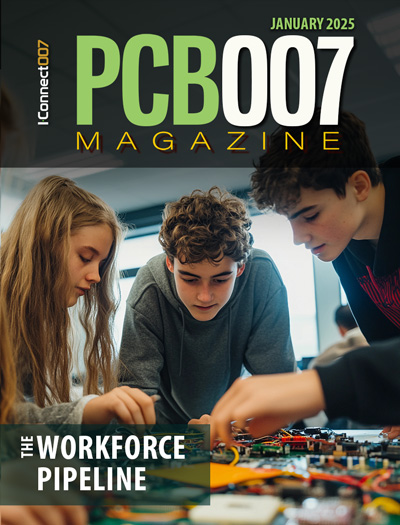-

- News
- Books
Featured Books
- pcb007 Magazine
Latest Issues
Current Issue
The Essential Guide to Surface Finishes
We go back to basics this month with a recount of a little history, and look forward to addressing the many challenges that high density, high frequency, adhesion, SI, and corrosion concerns for harsh environments bring to the fore. We compare and contrast surface finishes by type and application, take a hard look at the many iterations of gold plating, and address palladium as a surface finish.

It's Show Time!
In this month’s issue of PCB007 Magazine we reimagine the possibilities featuring stories all about IPC APEX EXPO 2025—covering what to look forward to, and what you don’t want to miss.

Fueling the Workforce Pipeline
We take a hard look at fueling the workforce pipeline, specifically at the early introduction of manufacturing concepts and business to young people in this issue of PCB007 Magazine.
- Articles
- Columns
Search Console
- Links
- Media kit
||| MENU - pcb007 Magazine
Estimated reading time: 2 minutes
All About Flex: Copper Grain Direction
Many materials have different characteristics depending upon the orientation of the material. For example, woven textile materials have a warp and a weft direction. The warp direction is the longitude direction and the weft is the transverse. The cloth will behave differently depending on which direction the tension is applied. Copper foils also behave differently depending on the orientation of the material. Two common categories of copper used are ED (electrodeposited) copper and RA (rolled annealed). Orientation is generally not critical for ED copper, but it can be critical for RA.
To better understand why orientation may be critical, it helps to understand how copper is formed into the thin planes required for circuit fabrication. Electrodeposited copper is produced by using direct current to dissolve copper anodes and plate them from solution onto a stainless-steel drum (the cathode). The copper is then rolled onto a spool, thereby creating a continuous roll of copper foil. The rotational speed of the drum is adjusted to alter the thickness of the copper. There are multiple types of ED copper with varying surface roughness and grain structure. With flexible circuit fabrication, surface roughness can provide different adhesion properties and/or chemical resistance when the foil is subsequently bonded with an adhesive to a polyimide film.
Rolled annealed copper is produced by taking billets of thick copper and rolling them under extremely high pressure to produce a desired thickness. Rolling oils are added to enhance the thickness reduction process. These oils need to be chemically removed before any lamination processes. Figure 1 depicts the RA process.
Figure 1: Rolled annealed copper manufacturing process.
Rolled annealed copper will have an elongated grain structure parallel to the material direction. Electrodeposited copper is characterized by a more random and vertical grain structure that has no specific material direction orientation. RA copper is smoother and has better elongation properties. Oxide treatments or mechanical abrasion is often applied to rolled copper to create bond enhancement properties.
RA copper is used extensively in bending applications. Circuit orientation on the panel relative to the grain direction is important to maximize flex life, especially in dynamic flexing applications. Grain direction is positioned perpendicular to the bend axis as bending across the grain will negate the inherent advantages of the elongated grain structure. Figure 2 gives shows a side-by-side comparison of the grain structure between ED and RA.
Figure 2: Comparison of grain structures in RA and ED copper foils.
If an application requires some—or a lot—of flexing, the fabricator should be made aware of bend location and desired flex life. In addition to copper type, several design conventions are used to maximize flex life. These include copper thickness, bend radius, component and via locations, and position of copper in the circuit construction. Knowing the flex life expectations of a particular application allows the fabricator to optimize a construction to best meet product life requirements.
Rolled annealed copper has become standard fare in the flexcircuit world. It generally provides the most robust end product and in many applications, will be a bit more forgiving than electrodeposited foil. Because RA copper has a smoother surface than ED, it is often used in high-speed electronics or microwave applications. ED copper allows for better surface adhesion, has slightly better conductivity, and is used almost exclusively in the world of rigid printed circuits.
Dave Becker is vice president of sales and marketing at All Flex Flexible Circuits LLC.
More Columns from All About Flex
All About Flex: Terms and ConditionsAll About Flex: ISO 9001 Basics
All About Flex: FAQs on UL Listings for Flexible Circuits
All About Flex: Avoiding Trace Fracturing in a Flexible Circuit
Polyimide vs. Silicone for Flexible Heaters
All About Flex: Copper Thickness Requirements for Flex Circuits
All About Flex: Options for Purchasing Flexible Heaters
All About Flex: More on UAVs and Flexible Circuits


